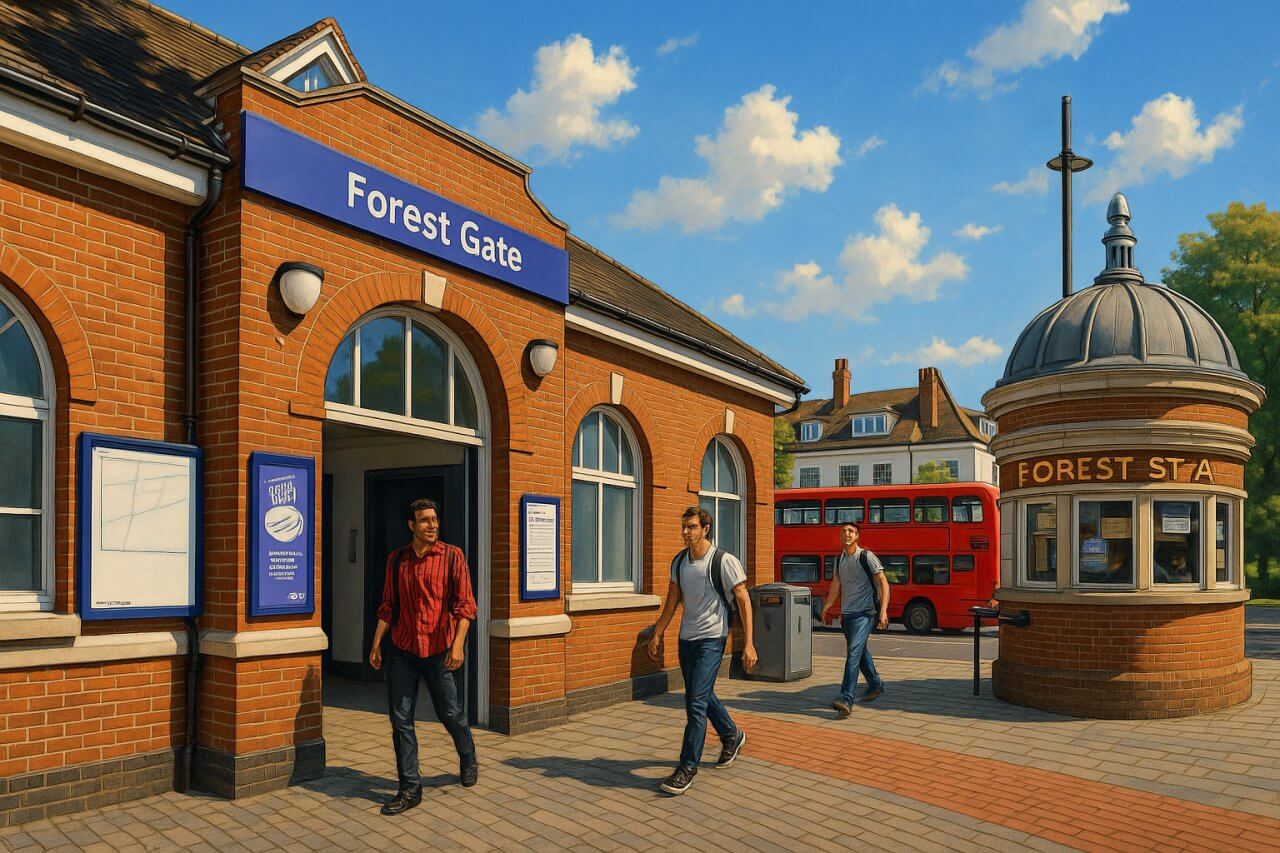
Forest Gate Station, London
Forest Gate Station is a key railway station located in East London, within the London Borough of Newham. Situated on the Elizabeth Line, it provides rapid east-west connections across the capital and beyond. While not part of the London Underground network, it serves as an important transport hub for commuters and visitors alike.
Location and Access
The station is situated on Woodgrange Road, a bustling local high street in Forest Gate. Its main entrance is on the east side of the road, adjacent to the junction with Forest Lane. The station has a modest ground-level brick building that houses a ticket hall, automated ticket machines, and a small kiosk.
There is no subterranean entrance or expansive concourse like some major London stations. However, the station has been significantly upgraded in recent years to accommodate the Elizabeth Line, with step-free access provided via lifts and modern platform facilities.
Historical Background
Forest Gate Station was originally opened in 1840 by the Eastern Counties Railway. It was part of the original London to Norwich route and has since been absorbed into the Great Eastern Main Line. The name “Forest Gate” is believed to derive from a gate in the nearby forest wall that once marked the entrance to Epping Forest — hence the term "Forest Gate."
From its inception, the station bore the same name, reflecting the local area's identity and historical ties to Epping Forest.
Proximity to Central London
By road, Forest Gate Station lies approximately 7.5 miles (12 kilometres) northeast of Charing Cross, often considered the traditional centre of central London.
Rail Services and Connections
Forest Gate Station is served exclusively by the Elizabeth Line and National Rail services operated by TfL Rail. Though not part of the London Underground Stations network, it offers easy interchange opportunities at nearby hubs such as Stratford and Liverpool Street.
Elizabeth Line
On the Elizabeth Line, Forest Gate sits between Maryland to the west and Manor Park to the east. Services run at high frequency, with 8 to 12 trains per hour during peak times.
Westbound: The previous station is Maryland. Beyond that, trains continue through Stratford, Liverpool Street, and into the City and central London, ultimately reaching Heathrow Airport or Reading Station at the western terminus.
Eastbound: The next station is Manor Park, with services continuing on to Abbey Wood Station and, eventually, Shenfield.
Fares and Journey Times
- To Reading Station:
- Adult single fare: £23.30
- Adult pay-as-you-go (Oyster/contactless): £17.20 (peak), £14.00 (off-peak)
- Estimated journey time: Approximately 1 hour 20 minutes
- To Abbey Wood Station:
- Adult single fare: £4.40
- Adult pay-as-you-go (Oyster/contactless): £2.70 (off-peak), £2.90 (peak)
- Estimated journey time: Around 25 minutes
- To Charing Cross Station:
- Route: Elizabeth Line to Tottenham Court Road → Northern Line to Embankment → Short walk
- Adult single fare: £6.80
- Adult pay-as-you-go (Oyster/contactless): £3.70 (off-peak), £4.00 (peak)
- Estimated journey time: About 35–40 minutes
Fun Fact
Forest Gate is one of several East London stations that underwent significant transformation for the launch of the Elizabeth Line. The new platforms are longer than standard ones to accommodate the 200-metre-long trains, which can carry up to 1,500 passengers each. This upgrade was part of a £2.5 billion investment in station infrastructure across the line.
Quick Facts
- Location: Woodgrange Road, Forest Gate, East London
- Local Authority: London Borough of Newham
- Opened: 1840 (by Eastern Counties Railway)
- Lines Served: Elizabeth Line, National Rail (TfL Rail)
- Previous Elizabeth Line Station: Maryland (westbound)
- Next Elizabeth Line Station: Manor Park (eastbound)
- Distance from Charing Cross: Approx. 7.5 miles (12 km)
- Building Type: Ground-level brick structure with ticket hall and kiosk
- Accessibility: Step-free access with lifts
- Fun Fact: Station platforms extended for Elizabeth Line’s 200-metre trains
- Fare to Reading (Peak): £17.20 by Oyster/contactless
- Fare to Abbey Wood (Off-peak): £2.70 by Oyster/contactless
- Fare to Charing Cross (Off-peak): £3.70 by Oyster/contactless
- Estimated Journey Time to Charing Cross: 35–40 minutes
Forest Gate Station is  on the Map of London Underground
on the Map of London Underground

Painting of Forest Gate Station, London (View image in full size)